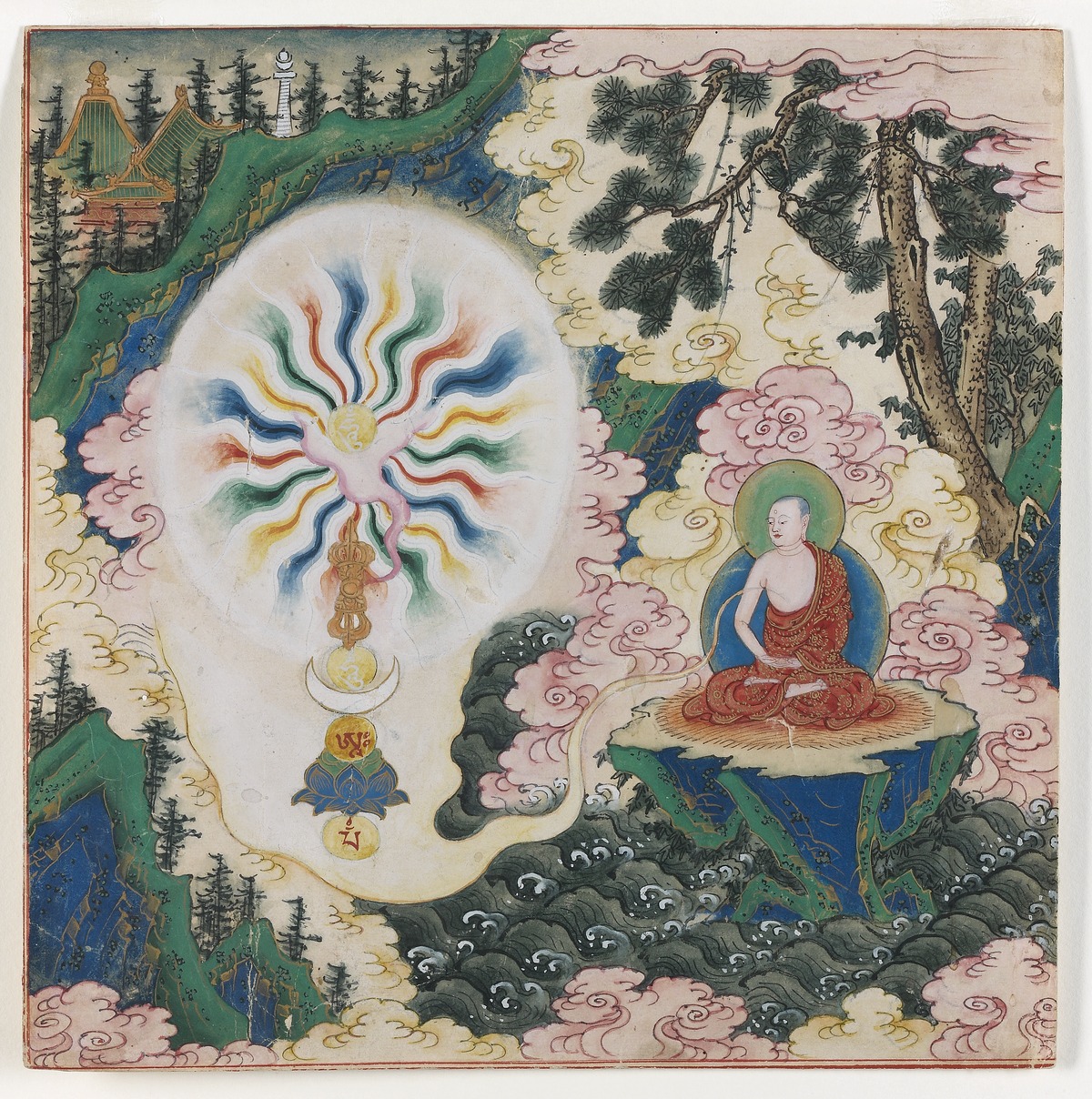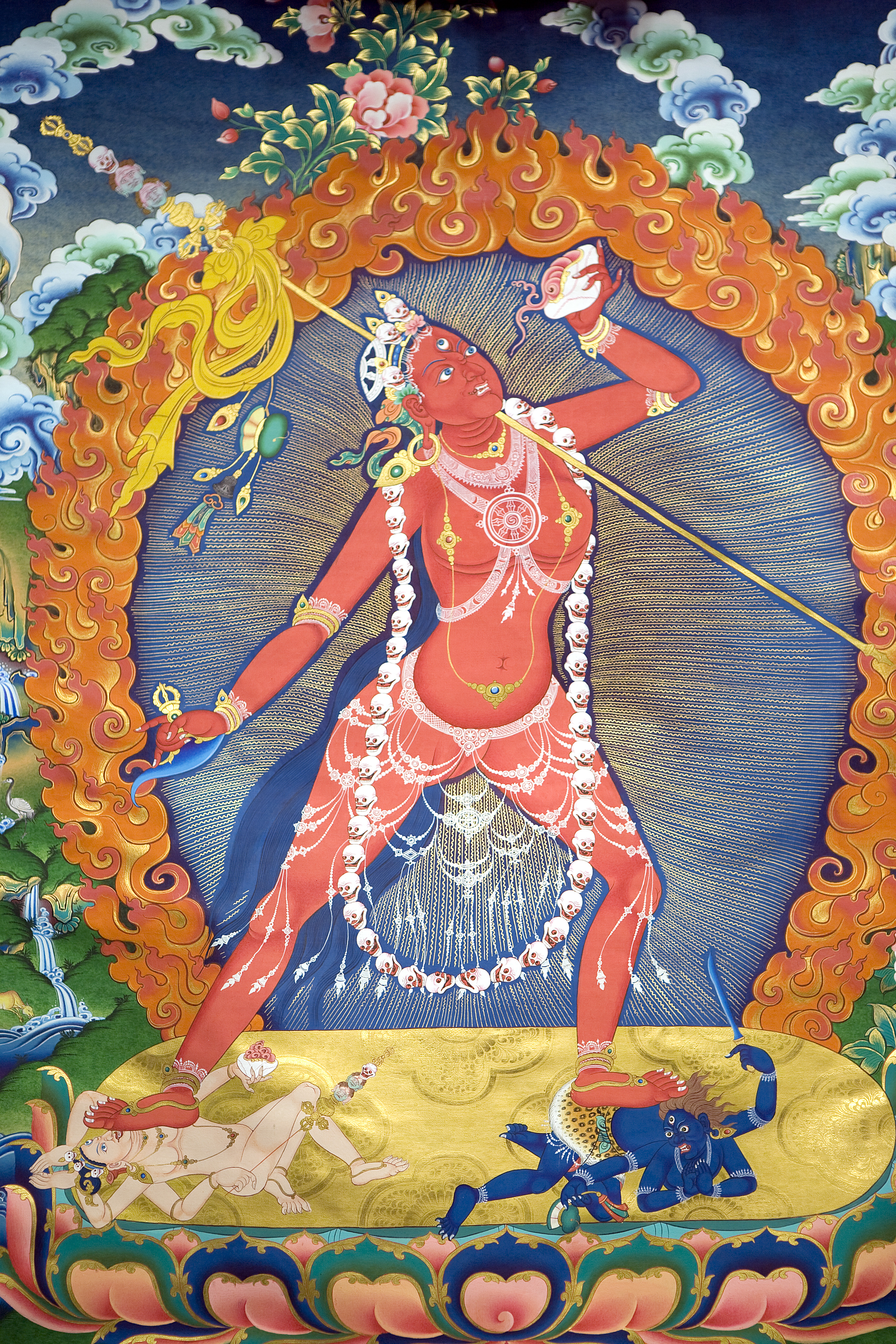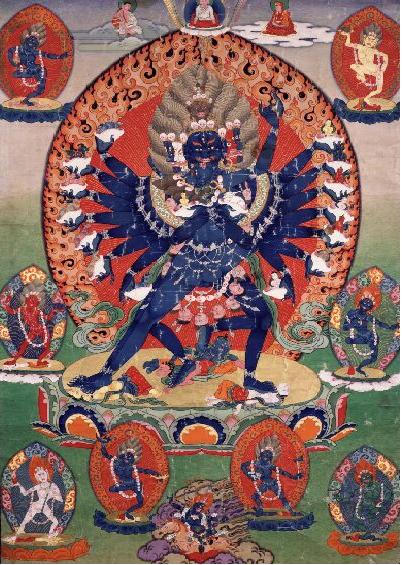|
Yidam
''Yidam'' is a type of deity associated with tantric or Vajrayana Buddhism said to be manifestations of Buddhahood or enlightened mind. During personal meditation (''sādhana'') practice, the yogi identifies their own form, attributes and mind with those of a yidam for the purpose of transformation. Yidam is sometimes translated by the terms "meditational deity" or "tutelary deity". Examples of yidams include the meditation deities Chakrasamvara, Kalachakra, Hevajra, Yamantaka, and Vajrayogini, all of whom have a distinctive iconography, mandala, mantra, rites of invocation and practice. In Vajrayana, the yidam is one of the three roots of the inner refuge formula and is also the key element of deity yoga since the 'deity' in the yoga is the yidam. Etymology Yidam is said to be a contraction of Tib. ''yid-kyi-dam-tshig'', meaning "samaya of mind" or in other words, the state of being indestructibly bonded with the inherently pure and liberated nature of mind. This is s ... [...More Info...] [...Related Items...] OR: [Wikipedia] [Google] [Baidu] |
Three Roots
In Buddhism, the Three Jewels, Triple Gem, or Three Refuges are the supports in which a Buddhist takes refuge by means of a prayer or recitation at the beginning of the day or of a practice session. These Three Jewels are: * The Buddha, the fully enlightened one * The Dharma, the teachings expounded by the Buddha * The Saṅgha, the monastic order of Buddhism that practice Dharmas. The Three Roots (Tibetan: ''tsa sum'') of the Tibetan Buddhist tradition are the lama (Sanskrit: ''guru''), yidam (Sanskrit: ''ishtadevata''), and protector, which may be a ''khandroma'' (Sanskrit: ''dakini'') or ''chökyong'' (Sanskrit: ''dharmapala''). The Three Roots are the second of three Tibetan Buddhist refuge formulations, the ''Outer'', ''Inner'' and ''Secret'' forms of the Three Jewels. The 'Outer' form is the 'Triple Gem', (Sanskrit:''triratna''), the 'Inner' is the Three Roots and the 'Secret' form is the 'Three Bodies' or trikāya of a Buddha. The additional refuge formulations are e ... [...More Info...] [...Related Items...] OR: [Wikipedia] [Google] [Baidu] |
Dakini
A ḍākinī ( sa, डाकिनी; ; mn, хандарма; ; alternatively 荼枳尼, ; 荼吉尼, ; or 吒枳尼, ; Japanese: 荼枳尼 / 吒枳尼 / 荼吉尼, ''dakini'') is a type of female spirit, goddess, or demon in Hinduism and Buddhism. The concept of the ḍākinī somewhat differs depending on the context and the tradition. For instance, in earlier Hindu texts and East Asian esoteric Buddhism, the term denotes a race of demonesses who ate the flesh and/or vital essence of humans. In Hindu Tantric literature, Ḍākinī is the name of a goddess often associated with one of the six chakras or the seven fundamental elements ('' dhātu'') of the human body. In Nepalese and Tibetan Buddhism, meanwhile, 'ḍākinī' (also wisdom ḍākinī) can refer to both what can be best described as fierce-looking female embodiments of enlightened energy and to human women with a certain amount of spiritual development, both of which can help Tantric initiates attaining enli ... [...More Info...] [...Related Items...] OR: [Wikipedia] [Google] [Baidu] |
Vajrayana
Vajrayāna ( sa, वज्रयान, "thunderbolt vehicle", "diamond vehicle", or "indestructible vehicle"), along with Mantrayāna, Guhyamantrayāna, Tantrayāna, Secret Mantra, Tantric Buddhism, and Esoteric Buddhism, are names referring to Buddhist traditions associated with Tantra and "Secret Mantra", which developed in the medieval Indian subcontinent and spread to Tibet, Nepal, other Himalayan states, East Asia, and Mongolia. Vajrayāna practices are connected to specific lineages in Buddhism, through the teachings of lineage holders. Others might generally refer to texts as the Buddhist Tantras. It includes practices that make use of mantras, dharanis, mudras, mandalas and the visualization of deities and Buddhas. Traditional Vajrayāna sources say that the tantras and the lineage of Vajrayāna were taught by Śākyamuni Buddha and other figures such as the bodhisattva Vajrapani and Padmasambhava. Contemporary historians of Buddhist studies meanwhile argue that ... [...More Info...] [...Related Items...] OR: [Wikipedia] [Google] [Baidu] |
Deity Yoga
The fundamental practice of Vajrayana and Tibetan tantra is deity yoga (''devatayoga''), meditation on a chosen deity or "cherished divinity" (Skt. ''Iṣṭa-devatā,'' Tib. ''yidam''), which involves the recitation of mantras, prayers and visualization of the deity, the associated mandala of the deity's Buddha field, along with consorts and attendant Buddhas and bodhisattvas. According to the Tibetan scholar Tsongkhapa, deity yoga is what separates Tantra from Sutra practice. In the Unsurpassed Yoga Tantras, the most widespread tantric form in Indo-Tibetan Buddhism, this method is divided into two stages, the generation stage (''utpatti-krama'') and the completion stage (''nispanna-krama''). In the generation stage, one dissolves one's reality into emptiness and meditates on the deity-mandala, resulting in identification with this divine reality. In the completion stage, the divine image along with the subtle body is applied to the realization of luminous emptiness. The In ... [...More Info...] [...Related Items...] OR: [Wikipedia] [Google] [Baidu] |
Vajrayogini
Vajrayoginī ( sa, italic=yes, Vajrayoginī वज्रयोगिनी; , Dorjé Neljorma; mn, Огторгуйд Одогч, Нархажид, ) is a Tantric Buddhist female Buddha and a . The ''Vajrayogini'' cult dates back to the tenth and twelfth centuries. Vajrayoginī's essence is "great passion" (''maharaga''), a transcendent passion that is free of selfishness and illusion—she intensely works for the well-being of others and for the destruction of ego clinging. She is seen as being ideally suited for people with strong passions, providing the way to transform those passions into enlightened virtues. She is an Anuttarayoga Tantra iṣṭadevatā (meditation deity) and her practice includes methods for preventing ordinary death, intermediate state ( bardo) and rebirth ( samsara) by transforming them into paths to enlightenment, and for transforming all mundane daily experiences into higher spiritual paths. Practices associated with her are Chöd and the Six Yogas ... [...More Info...] [...Related Items...] OR: [Wikipedia] [Google] [Baidu] |
Tibetan Buddhist
Tibetan Buddhism (also referred to as Indo-Tibetan Buddhism, Lamaism, Lamaistic Buddhism, Himalayan Buddhism, and Northern Buddhism) is the form of Buddhism practiced in Tibet and Bhutan, where it is the dominant religion. It is also in majority regions surrounding the Himalayan areas of India (such as Ladakh, Sikkim, Arunachal Pradesh, and a minority in Himachal Pradesh and Uttarakhand), in much of Central Asia, in the southern Siberian regions such as Tuva, and in Mongolia. Tibetan Buddhism evolved as a form of Mahāyāna Buddhism stemming from the latest stages of Indian Buddhism (which also included many Vajrayāna elements). It thus preserves many Indian Buddhist tantric practices of the post-Gupta early medieval period (500 to 1200 CE), along with numerous native Tibetan developments. In the pre-modern era, Tibetan Buddhism spread outside of Tibet primarily due to the influence of the Mongol Yuan dynasty (1271–1368), founded by Kublai Khan, which had ruled China, ... [...More Info...] [...Related Items...] OR: [Wikipedia] [Google] [Baidu] |
Kalachakra
''Kālacakra'' () is a polysemic term in Vajrayana Buddhism that means " wheel of time" or "time cycles". "''Kālacakra''" is also the name of a series of Buddhist texts and a major practice lineage in Indian Buddhism and Tibetan Buddhism. The tantra is considered to belong to the unexcelled yoga ('' anuttara-yoga'') class. Kālacakra also refers both to a patron tantric deity or yidam in Vajrayana and to the philosophies and yogas of the Kālacakra tradition. The tradition's origins are in India and its most active later history and presence has been in Tibet. The tradition contains teachings on cosmology, theology, philosophy, sociology, soteriology, myth, prophecy, medicine and yoga. It depicts a mythic reality whereby cosmic and socio-historical events correspond to processes in the bodies of individuals. These teachings are meant to lead to a transformation of one's body and mind into perfect Buddhahood through various yogic methods. The Kālacakra tradition is based o ... [...More Info...] [...Related Items...] OR: [Wikipedia] [Google] [Baidu] |
Hevajra
Hevajra ( Tibetan: kye'i rdo rje / kye rdo rje; Chinese: 喜金剛 Xǐ jīngāng / 呼金剛 Hū jīngāng;) is one of the main yidams (enlightened beings) in Tantric, or Vajrayana Buddhism. Hevajra's consort is Nairātmyā (Tibetan: bdag med ma). History India The Hevajra Tantra, a yoginītantra of the ''anuttarayogatantra'' class, is believed to have originated between the late 8th (Snellgrove), and the late 9th or early 10th centuries (Davidson), in Eastern India, possibly Kamarupa. Tāranātha lists Saroruha and Kampala (also known as "Lva-va-pā", "Kambhalī", and "Śrī-prabhada") as its "bringers": .. the foremost yogi Virupa meditated on the path of Yamāri and attained siddhi under the blessings of Vajravārāhi,...His disciple Dombi Heruka..understood the essence of the Hevajra Tantra, and composed many śāstras like the ''Nairātmā-devi-sādhana'' and the ''Sahaja-siddhi''. He also conferred abhiṣeka on his own disciples. After this, two ācāryas ... [...More Info...] [...Related Items...] OR: [Wikipedia] [Google] [Baidu] |
Mandala
A mandala ( sa, मण्डल, maṇḍala, circle, ) is a geometric configuration of symbols. In various spiritual traditions, mandalas may be employed for focusing attention of practitioners and adepts, as a spiritual guidance tool, for establishing a sacred space and as an aid to meditation and trance induction. In the Eastern religions of Hinduism, Buddhism, Jainism and Shinto it is used as a map representing deities, or especially in the case of Shinto, paradises, kami or actual shrines. A mandala generally represents the spiritual journey, starting from outside to the inner core, through layers. Hinduism In Hinduism, a basic mandala, also called a ''yantra'', takes the form of a square with four gates containing a circle with a center point. Each gate is in the general shape of a T. Mandalas often have radial balance. A ''yantra'' is similar to a mandala, usually smaller and using a more limited colour palette. It may be a two- or three-dimensional geometric compo ... [...More Info...] [...Related Items...] OR: [Wikipedia] [Google] [Baidu] |
Lama
Lama (; "chief") is a title for a teacher of the Dharma in Tibetan Buddhism. The name is similar to the Sanskrit term ''guru'', meaning "heavy one", endowed with qualities the student will eventually embody. The Tibetan word "lama" means "highest principle", and less literally "highest mother" or "highest parent" to show close relationship between teacher and student."lama" from Historically, the term was used for venerated spiritual masters or heads of monasteries. Today the title can be used as an [...More Info...] [...Related Items...] OR: [Wikipedia] [Google] [Baidu] |
Buddhist
Buddhism ( , ), also known as Buddha Dharma and Dharmavinaya (), is an Indian religion or philosophical tradition based on teachings attributed to the Buddha. It originated in northern India as a -movement in the 5th century BCE, and gradually spread throughout much of Asia via the Silk Road. It is the world's fourth-largest religion, with over 520 million followers (Buddhists) who comprise seven percent of the global population. The Buddha taught the Middle Way, a path of spiritual development that avoids both extreme asceticism and hedonism. It aims at liberation from clinging and craving to things which are impermanent (), incapable of satisfying ('), and without a lasting essence (), ending the cycle of death and rebirth (). A summary of this path is expressed in the Noble Eightfold Path, a training of the mind with observance of Buddhist ethics and meditation. Other widely observed practices include: monasticism; " taking refuge" in the Buddha, the , and th ... [...More Info...] [...Related Items...] OR: [Wikipedia] [Google] [Baidu] |
Buddhism
Buddhism ( , ), also known as Buddha Dharma and Dharmavinaya (), is an Indian religions, Indian religion or Indian philosophy#Buddhist philosophy, philosophical tradition based on Pre-sectarian Buddhism, teachings attributed to the Buddha. It originated in History of India, northern India as a -movement in the 5th century BCE, and Silk Road transmission of Buddhism, gradually spread throughout much of Asia via the Silk Road. It is the Major religious groups, world's fourth-largest religion, with over 520 million followers (Buddhists) who comprise seven percent of the global population. The Buddha taught the Middle Way, a path of spiritual development that avoids both extreme asceticism and hedonism. It aims at liberation from clinging and craving to things which are impermanent (), incapable of satisfying ('), and without a lasting essence (), ending the cycle of death and rebirth (). A summary of this path is expressed in the Noble Eightfold Path, a Bhavana, training of t ... [...More Info...] [...Related Items...] OR: [Wikipedia] [Google] [Baidu] |

_(8697431158).jpg)


.jpeg/1200px-Tibetan_Buddhism_(214837929).jpeg)



